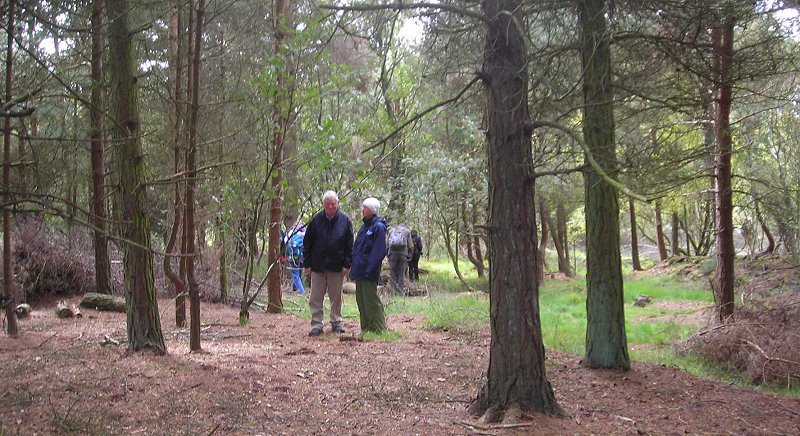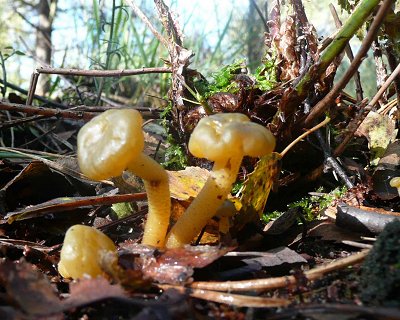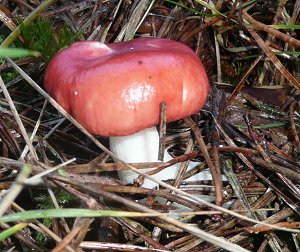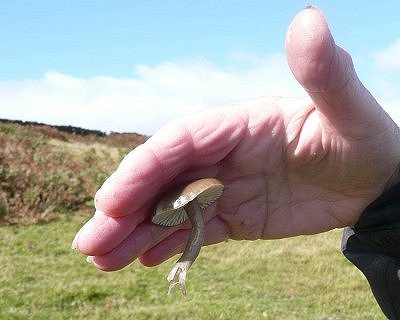
Back to the Home page
species list below
Twelve of us met on the edge of the moor just north of Sykes House, keen to find some ‘Waxcaps’. Waxcaps are a group of mushrooms that grow in grassland and, being much smaller than many familiar woodland fungi, are quite difficult to see. However, they are often lovely bright colours and once you start looking you might be surprised at the variety found in an ordinary looking bit of unimproved grassland. We certainly think we found nine species in various shades of yellow, red, green and grey.

Firstly we walked south down the road seeing Psathyrella multipedata – the clustered Brittle Stem, growing on a pile of woodchips and then through a little piece of pine and birch woodland on the edge of the moor where we found lots of different fungi.
 Growing along the sides of the very dank path were lots of Jelly Babies – Leotia lubrica. These look like little greenish-yellow rubbery ‘mushrooms’. However they belong to the less familiar second group of fungi called ASCOMYCETES (Cup fungi) and do not have gills or pores at all, although they look as if they should.
Growing along the sides of the very dank path were lots of Jelly Babies – Leotia lubrica. These look like little greenish-yellow rubbery ‘mushrooms’. However they belong to the less familiar second group of fungi called ASCOMYCETES (Cup fungi) and do not have gills or pores at all, although they look as if they should.
 There were also plenty of old wet Lactarius deterrimus along the path with their green-zoned caps and orange milk latex that turns wine-coloured after about half an hour. In under the Scots Pine trees on the needle strewn woodland floor there were many fungi including 3 species of Russula. A Yellow one Russula ochraleuca, a bright red one Russula emetica and an as yet undetermined dark red one.
There were also plenty of old wet Lactarius deterrimus along the path with their green-zoned caps and orange milk latex that turns wine-coloured after about half an hour. In under the Scots Pine trees on the needle strewn woodland floor there were many fungi including 3 species of Russula. A Yellow one Russula ochraleuca, a bright red one Russula emetica and an as yet undetermined dark red one.
Scattered amongst these were little groups of delicate white and beige mushrooms with white gills and bendy stipes. When I got them home and looked under the microscope I could see they were growing on the bodies of old blackened mushrooms, and that is a characteristic of Collybia cirrhata – the Piggy Back Shanklet which grows on the remains of Lactarius and Russula mushrooms.

 Out on the short route across the heather we barely saw any more fungi until we reached the old grassland on the slope down to Harland Beck, where we began to see the waxcaps. Identification of waxcaps is firstly based on colour, the shape of the gills and whether the cap and or stipe are Viscid, i.e STICKY. This was quite difficult to determine at first with people holding them to their faces or lips or describing them as ‘slimy’ or not, but then there was one VERY viscid one – the larger greyish Hygrocybe irrigata and it was so sticky that it stuck to Keith’s fingers making identification easy.
Out on the short route across the heather we barely saw any more fungi until we reached the old grassland on the slope down to Harland Beck, where we began to see the waxcaps. Identification of waxcaps is firstly based on colour, the shape of the gills and whether the cap and or stipe are Viscid, i.e STICKY. This was quite difficult to determine at first with people holding them to their faces or lips or describing them as ‘slimy’ or not, but then there was one VERY viscid one – the larger greyish Hygrocybe irrigata and it was so sticky that it stuck to Keith’s fingers making identification easy.
You can see (below)the range of species we found and identified using The Quick Waxcap Key from David Boertmann’s book The Genus Hygrocybe. We also saw the Blackening Waxcap Hygrocybe conica but do not have a photo of it. [Ed: there is a good photo here by Stuart Dunlop, on his excellent Donegal Wildlife site.]
|
|
|
|
|
|
|
|
The intrepid Forayers finally had to negotiate a couple of walls and fences to get back to Tom Denney’s land. I thank him for his assistance. For those especially interested in fungi there was plenty to keep them interested and for anyone else it was a beautiful day in a beautiful bit of Ryedale with wonderful views and a lovely walk.
[Ed: Many thanks to Rhona for leading this interesting foray and providing the notes, pictures and species list below.]
Species seen:
| Latin name | Common name |
| Amanita muscaria | Fly Agaric |
| Amanita rubescens | Blusher |
| Clavulinopsis helvola | Yellow Club |
| Clavulinopsis laeticolor | Handsome Club |
| Collybia cirrhata | Piggyback Shanklet |
| Cordyceps militaris | Scarlet Caterpillarclub |
| Cystoderma amianthinum | Earthy Powdercap |
| Hygrocybe ceracea | Butter Waxcap |
| Hygrocybe chlorophana | Golden Waxcap |
| Hygrocybe conica | Blackening Waxcap |
| Hygrocybe insipida | Spangle Waxcap |
| Hygrocybe irrigata | Slimy Waxcap |
| Hygrocybe pratensis | Meadow Waxcap |
| Hygrocybe psittacina | Parrot Waxcap |
| Hygrocybe reidii | Honey Waxcap |
| Laccaria laccata | Deceiver |
| Leotia lubrica | Jellybaby |
| Lycoperdon nigrescens | Dusky Puffball |
| Lycoperdon perlatum | Common Puffball |
| Paxillus involutus | Brown Rollrim |
| Psathyrella multipedata | Clustered Brittlestem |
| Psilocybe semilanceata | Magic Mushroom / Liberty Cap |
| Russula ochroleuca | Ochre Brittlegill |
| Russula emetica | The Sickener |
| Suillus bovinus | Bovine Bolete |
| Tremella foliacea | Leafy Brain |
| Tricholomopsis rutilans | Plums and Custard |
| Xylaria hypoxylon | Candlesnuff Fungus |
| © Ryedale Natural History Society 2012 Photos © Rhona Sutherland 2012 | Back to the Home page |